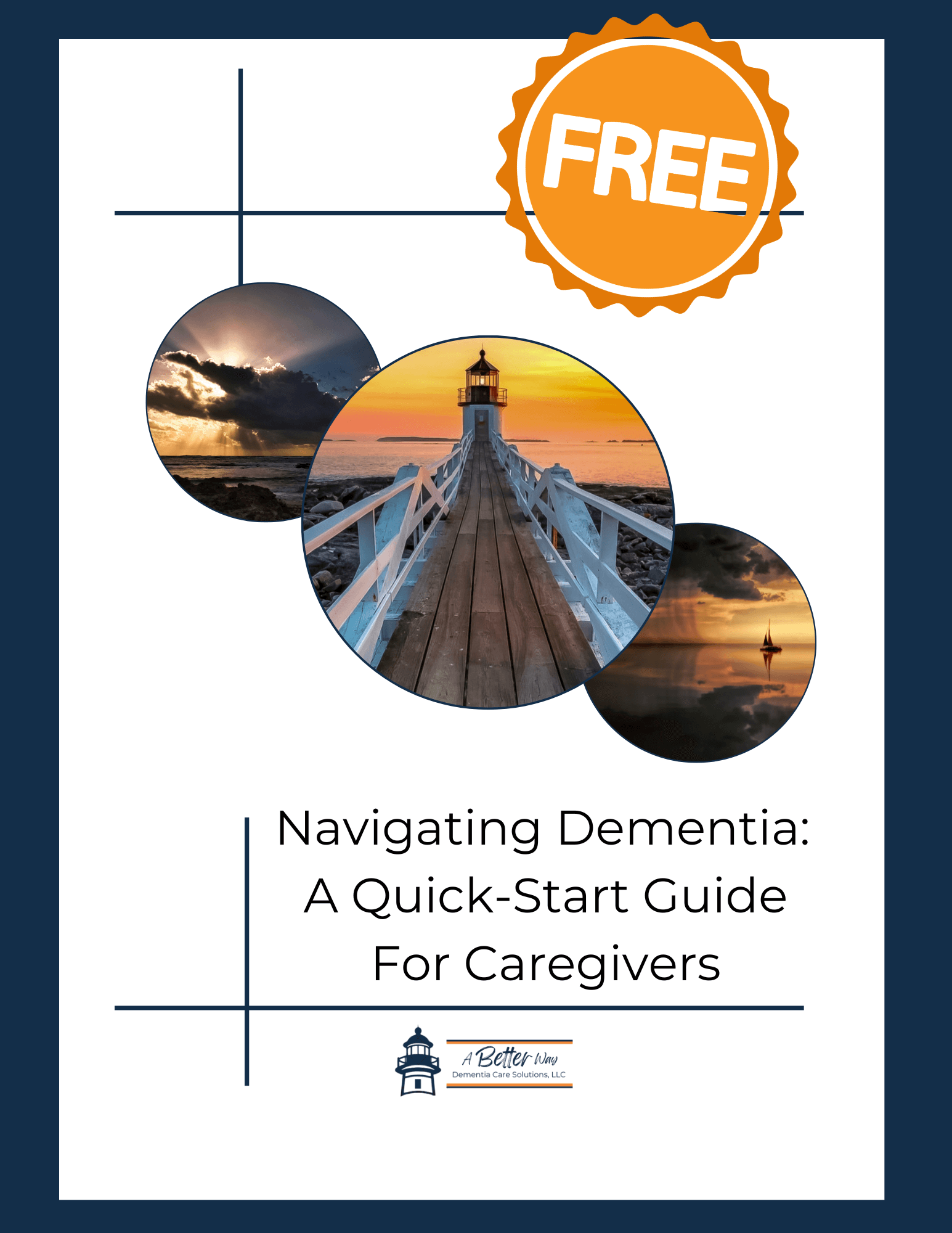
It starts as a quiet sigh at the dinner table-or maybe a tense silence. The food is untouched. The fork is held but not used. Or perhaps your person with dementia becomes agitated, pushing the plate away or accusing you of trying to harm them. What should have been a nourishing experience turns into a stressful scene for everyone involved.
If you’ve ever found yourself dreading mealtimes, you are not alone.
Feeding someone with dementia isn’t just about preparing food-it’s about navigating a shifting set of emotional, physical, and cognitive needs that change daily, sometimes hourly. The person you care for may not recognize food, forget how to use utensils, or be overwhelmed by the environment.
The good news is that with small, strategic changes, you can help transform mealtime from a struggle into something more calm, familiar, and even joyful.
In this post, I’ll walk you through the reasons behind common mealtime challenges in dementia care and offer practical solutions that are rooted in empathy and experience. You’ll learn techniques to make meals more appealing, reduce stress, and encourage safe, enjoyable eating-without the guilt, confusion, or burnout.
Because feeding someone you care about should be an act of love-not a battlefield.
Let’s explore how you can make mealtimes better, one bite-sized change at a time.
Meet Them Where They Are
By the time someone is living with moderate to advanced dementia, mealtime isn’t just about hunger-it’s a sensory, motor, and emotional challenge.
You might notice they:
- Refuse to sit down
- Push food away
- Chew but don’t swallow
- Eat with their hands even when utensils are available
- Say they’ve already eaten (even if it’s been hours)
These behaviors can be incredibly frustrating, especially when you’re trying your best to provide good care. It’s tempting to feel like you’re failing or that the person is being difficult on purpose.
But here’s the truth: it’s not stubbornness-it’s dementia.
As brain changes progress, people may:
- Lose the ability to recognize food or utensils (agnosia)
- Forget how to chew or swallow (apraxia and dysphagia)
- Feel overwhelmed by sounds, colors, or smells at the table
- Experience changes in taste and smell that make food unappealing
- Become fearful or paranoid about being poisoned (common in mid-stage dementia)
These behaviors are not personal-they are neurological.
But there’s hope. With the right environment, meal choices, and approach, many of these challenges can be reduced. And even if your person still struggles, you can feel more confident knowing you’re using strategies that meet them where they are.
In other words, you’re not trying to force the old way of eating. You’re creating a new way that works for their brain now.
You are already showing tremendous care. This next section will help you build on that foundation with strategies that actually work.
Educate with Heart: Strategies for Positive Mealtimes
Let’s break down the most effective ways to support better mealtimes-step by step.
1. Stick to a Routine
- Serve meals at the same times every day.
- Familiarity provides structure and reduces anxiety.
- Even if they forget the time, their body will remember the rhythm.
2. Create a Calm Mealtime Environment
- Turn off the TV and reduce background noise.
- Avoid busy table settings or loud conversations.
- Soft lighting and music can create a relaxed mood.
- Sit at eye level and make gentle eye contact-this builds trust.
3. Use Visual Cues
- Use plates that contrast with the food (e.g., red or blue plates).
- Avoid white-on-white (chicken and mashed potatoes on a white plate).
- Offer only a few food items at a time to reduce overwhelm.
- Avoid patterned or busy tablecloths.
4. Offer Foods They Can Eat Independently
- Finger foods like cut fruit, sandwiches, muffins, or cheese cubes encourage self-feeding.
- Adaptive utensils with large grips or built-in angles help those with motor challenges.
- Try pre-cut meals to reduce the need for coordination.
5. Focus on Familiar and Favorite Foods
- Memory is tied to emotion. Foods from childhood or cultural traditions often spark recognition.
- Don’t worry about “balanced meals” every time-getting calories and fluids in is more important.
6. Encourage Hydration
- Offer water in see-through cups.
- Use fun cups with straws or built-in handles.
- Add flavor: a splash of juice, cucumber slices, or lemon wedges.
- Offer popsicles, jello, or soup broths if drinking is hard.
7. Make Mealtime Feel Special
- Sit and eat with them, even if you’re not hungry.
- Smile. Laugh. Compliment the food. These cues matter more than the meal itself.
- Use the moment as a connection point rather than a task to complete.
Emotional Insight + Transformation
What would it feel like to stop dreading dinner?
Imagine a mealtime where your person hums softly to background music while eating half a sandwich. Where no one argues. Where you leave the table feeling calm, instead of defeated.
It is possible.
Maybe it’s not the full plate being finished-but a few bites eaten with dignity. Maybe the shift isn’t in what they do-but how you feel while doing it.
Your expectations may change, and so will theirs. But connection is still on the table.
That’s the heart of dementia care. We adjust-not because we’ve given up, but because we’ve chosen love over resistance.
You’ve already made it this far. You’re showing up, asking for help, and seeking new ways to ease the challenges.
And that, caregiver, is a beautiful thing.
Product Recommendations / Resources
Here are a few tried-and-true tools that make a big difference at mealtime:
- Red Plate Set for Dementia – Increases food recognition and intake. Buy it on Amazon
- Adaptive Silverware Set – Designed for comfort and ease of use with tremors or arthritis. buy it on amazon
- Anti-Slip Placemats – Keeps dishes in place and reduces spills. Buy it on amazon
- Weighted Cups with Handles – Great for shaky hands and promote independence. Buy it on amazon
- Ensure Nutritional Drinks – Provide extra calories and nutrients when eating is limited. buy it on amazon
- Glucerna Nutritional Drinks – Provide extra calories and nutrients when eating is limited for diabetics. buy it on amazon
Always consult your healthcare provider before making dietary changes or introducing supplements.
Practical Next Steps
Here are five small changes to try at your next mealtime:
- Use a red plate with only two items on it. See if that changes how much they eat.
- Play soft instrumental music from their era-big band, country, or show tunes.
- Offer a smoothie or milkshake as a snack between meals if eating is limited.
- Sit down and eat with them-modeling is one of the best strategies in dementia care.
- Reduce talking during meals and give them time to process between bites
You don’t have to figure this out alone.
Subscribe to our newsletter to receive weekly caregiver tips, practical tools, and encouragement delivered right to your inbox. You’ll also get instant access to:
FREE Guide: Mealtime Made Easier – Nutrition Tips for Dementia Caregivers Click here to sign up
If you need more personal support, I offer 1:1 dementia caregiver coaching to help you navigate challenges with confidence. Click here to learn more about coaching and how I can support you.
Together, we’re creating a better way to care.
Affiliate Disclosure:
A Better Way - Dementia Care Solutions, LLC participates in the Amazon Associates Program, which means we earn a small commission when you buy through links on our site, at no extra cost to you. We only recommend products that we believe can help caregivers on their journey.
Disclaimer:
The information provided in this blog is for educational purposes only and should not be considered medical advice. Always consult with a doctor or a licensed physical therapist before starting any new exercise routine, using assistive devices, or following the recommendations mentioned. Every individual’s needs are different, and professional guidance is essential to ensure safety and appropriateness of care.
Notes:
- Alzheimer’s Association. (2023). Dementia and nutrition. Retrieved from https://www.alz.org
- Keller, H. H., Carrier, N., Slaughter, S., et al. (2017). Making the Most of Mealtimes (M3): Protocol of a multi-centre cross-sectional study of food intake and its determinants in older adults living in long-term care homes. BMC Geriatrics, 17(1), 15.
- Palecek, E. J., Teno, J. M., Casarett, D. J., Hanson, L. C., & Rhodes, R. L. (2010). Comfort feeding only: A proposal to bring clarity to decision-making regarding difficulty with eating for persons with advanced dementia. Journal of the American Geriatrics Society, 58(3), 580–584.
Want to keep figuring this out together?
Subscribe to Finding Our Way in Dementia Care and get honest stories, helpful tips, and gentle support delivered to your inbox every week. Just real talk, grounded care, and space to breathe.
Subscribe to Finding Our Way in Dementia Care and get honest stories, helpful tips, and gentle support delivered to your inbox every week. Just real talk, grounded care, and space to breathe.
Kind truth. Clear steps. Warm guide.
















0 Comments